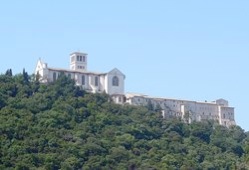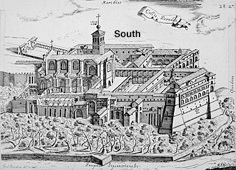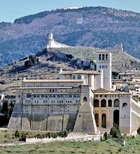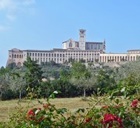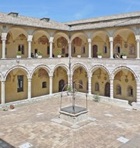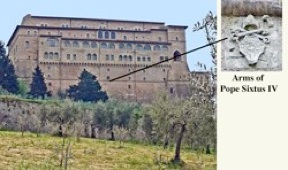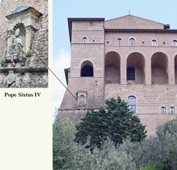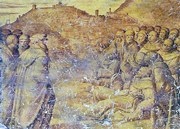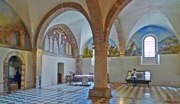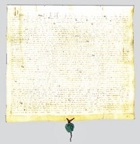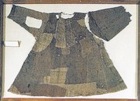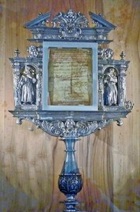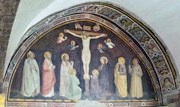The engraving (1703) by Francesco Providoni is now in Museo del Tesoro
The bull “Is qui ecclesiam” (1230) was addressed to the Minister General (Brother John Parenti) and the friars staying at San Francesco, which suggests that there was by this time a functioning convent next to the church. In 1238, Brother Giovanni da Penna built the aqueduct that supplied it with water. (Remains of it near Porta Perlici and near Santa Maria delle Rose are seen in Walk I).
According to Brother Salimbene (referenced below), Pope Gregory IX built a “magnificent palace” within the convent (in the north part of the present complex) for his own use. He presumably stayed in this palace during his short visit to Assisi in 1235. Brother Salimbene complained that Brother Elias spent most of his time in this palace, where he lived “too luxuriously, amid great pomp and splendour”. He also apparently rarely ate with the other friars but took his meals in his own room and kept his own personal cook.
Pope Innocent IV presumably stayed in the papal palace during this stay in Assisi in 1253, and seems to have consecrated the convent, which is therefore known as the Sacro Convento. (He also consecrated the altars of the upper and lower churches at this time.) The convent was exempted from the visitations of the provincial minister and the minister general of the order. Innocent IV returned for the month of May, 1254, some six months before he died.
Papal Palace
The papal palace at Assisi was, in fact, rarely used for its original purpose, since Orvieto and Perugia became preferred to Assisi as places of papal refuge:
-
✴In 1264, when Imperial forces threatened Pope Urban IV at Orvieto, he set out for Assisi, presumably intending to stay in it. However, he became ill when he reached Todi and only managed to continue as far as Perugia, where he died.
-
✴Pope Clement IV, stayed in Perugia for over a year after his election in February 1265, because Rome was too dangerous. He presumably used the palace at Assisi when he visited the city for a few days in September 1265 in order to venerate the relics of St Francis.
-
✴Pope Nicholas III, who had previously acted as Cardinal Protector of the Franciscans, attended the Franciscan General Chapter at Assisi in 1279.
-
✴Even the Franciscan Pope Nicholas IV spent his longest period of residence outside Rome (from June 1290 until October 1292) at Orvieto rather than at Assisi.
-
✴The next evidence of papal residence must wait until 1392, when Pope Boniface IX spent a few months here as a refugee from Perugia.
Additions to the Sacro Convento
In his will of 1367, Cardinal Gil Albornoz left a number of gifts for San Francesco, including 1,000 florins for the reconstruction of the infirmary in the west wing of the convent. The management of this project is attributed to Matteo di Giovannello, il Gattapone. (The historical context is set out in the page on San Francesco in the 14th century).
In 1472, Pope Sixtus IV:
-
✴reinforced the west wing by building a dramatic scarp wall behind the infirmary;
-
✴abandoned the old palace of Gregory IX for a new one to the south west (to the left in this illustration); and
-
✴commissioned the cloister behind the apse, which consists of arches in two storeys:
-
•documents in the archives of the Sacro Convento attribute the construction of this cloister to the Maestri Comacini;
-
•the coats of arms of Sixtus IV that decorate it are attributed to Franceschino Zampa.
The arms of Sixtus IV survive on the scarp wall, and his statue is housed in an aedicule on the north face of its right tower.
The original part of the convent (to the north, illustrated above) was re-opened and excavated in the period 1960-80.
-
✴The original Chapter Room (see below) now serves as the Cappella delle Reliquie.
-
✴Other rooms now house the Museo del Tesoro di San Francesco.
Scenes from the lives of SS Francis and Clare (1564-70)
These damaged monochrome frescoes by Dono Doni are in the lunettes around the cloister of Sixtus IV. The scene illustrated here depicts St Francis blessing Assisi as he is carried to the Portiuncula to die. The gallows on the hillside at the extreme left, below the Rocca Maggiore, stand on the site on which San Francesco would be built.
Chapter Room (Cappella delle Reliquie)
The door in the right transept of the lower church leads to the Chapter Room which was built in ca. 1230 and formed part of the papal palace. A number of important Franciscan relics are displayed here, including:
-
✴the Rule of the Friars Minor in the bull “
Solet annuere”, which was issued by Pope
Honorius III in 1223;
-
✴objects found in the tomb of St Francis when it was rediscovered in what is now the
crypt of San Francesco in 1818, including a few coins dating to the period 1181-1208 and the stone on which his head rested (illustrated here);
-
✴objects that the friars preserved as relics of St Francis, which include
-
-
•the felt slippers St Clare made for the stigmatised feet of St Francis; and
-
•two embroidered linen cloths that belonged to Lady Jacopa de' Settesoli, which were used to wipe the brow of the dying St Francis.
The relics also include the parchment on which
St Francis wrote an ecstatic prayer giving thanks for his stigmatisation, on the back of which he wrote a blessing for
Brother Leo and drew a picture of the cross on which Christ was crucified, planted in the head of Adam. The blessing translates: “May the Lord bless thee and keep thee. May He show His face to thee and have mercy on thee. May He turn His countenance to thee and give thee peace. Brother Leo, may the Lord bless thee”.
Additions written by Brother Leo explain the circumstances in which he received the blessing, which translates:
-
✴ "Blessed Francis wrote with his own hand this blessing for me, Brother Leo. ... In like manner he made this Tau (cross), together with the head, with his own hand"; and
-
✴"Blessed Francis two years before his death kept a Lent in the place of Mount La Verna in honour of the Blessed Virgin Mary, the Mother of the Lord, and of the blessed Michael the Archangel, from the feast of the Assumption of the holy Virgin Mary until the September feast of St. Michael. And the hand of the Lord was laid upon him; after the vision and speech of the Seraph and the impression of the Stigmata of Christ in his body he made and wrote with his own hand the Praises written on the other side of the sheet, giving thanks to the Lord for the benefits conferred on him."
Crucifixion with saints (ca. 1337)
This unfinished fresco, which is opposite the entrance to the Chapter Room from the lower church, was first documented in 1704. It is attributed to Puccio Capanna and was probably painted at about the same time as his frescoes in the Cappella di San Stanislao of the Lower Church.
The fresco depicts the Crucifixion with:
-
✴St Louis of Toulouse, the Virgin and St Paul on the left;
-
✴SS John the Evangelist, Peter and Antony of Padua to the right; and
-
✴SS Francis and Clare kneeling at the foot of the cross.
This was one of very few works executed at San Francesco during the period of papal interdict (1320-52), as set out in the page on San Francesco in the 14th Century.
Refectory (1760)
The “refettorio grande" (large refectory) of the Convento di San Francesco was rebuilt in 1760. Pietro Carattoli designed its stucco decoration (executed by Vincenzo Cenci di Foligno).
Confirmation of the Franciscan Rule (ca. 1760)
This fresco on the east wall is by Pietro Carattoli.


